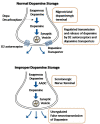Levodopa-Induced Dyskinesia in Parkinson's Disease: Pathogenesis and Emerging Treatment Strategies
- PMID: 36496996
- PMCID: PMC9736114
- DOI: 10.3390/cells11233736
Levodopa-Induced Dyskinesia in Parkinson's Disease: Pathogenesis and Emerging Treatment Strategies
Abstract
The most commonly used treatment for Parkinson's disease (PD) is levodopa, prescribed in conjunction with carbidopa. Virtually all patients with PD undergo dopamine replacement therapy using levodopa during the course of the disease's progression. However, despite the fact that levodopa is the "gold standard" in PD treatments and has the ability to significantly alleviate PD symptoms, it comes with side effects in advanced PD. Levodopa replacement therapy remains the current clinical treatment of choice for Parkinson's patients, but approximately 80% of the treated PD patients develop levodopa-induced dyskinesia (LID) in the advanced stages of the disease. A better understanding of the pathological mechanisms of LID and possible means of improvement would significantly improve the outcome of PD patients, reduce the complexity of medication use, and lower adverse effects, thus, improving the quality of life of patients and prolonging their life cycle. This review assesses the recent advancements in understanding the underlying mechanisms of LID and the therapeutic management options available after the emergence of LID in patients. We summarized the pathogenesis and the new treatments for LID-related PD and concluded that targeting pathways other than the dopaminergic pathway to treat LID has become a new possibility, and, currently, amantadine, drugs targeting 5-hydroxytryptamine receptors, and surgery for PD can target the Parkinson's symptoms caused by LID.
Keywords: Parkinson’s disease; dopamine; levodopa-induced dyskinesia; neurobiology of disease; treatment.
Conflict of interest statement
All authors declare no conflict of interest.
Figures





Similar articles
-
Levodopa-induced dyskinesia in Parkinson's disease: epidemiology, etiology, and treatment.Curr Neurol Neurosci Rep. 2007 Jul;7(4):302-10. doi: 10.1007/s11910-007-0046-y. Curr Neurol Neurosci Rep. 2007. PMID: 17618536 Review.
-
Extended-Release Amantadine for Levodopa-Induced Dyskinesia.Expert Rev Neurother. 2019 Apr;19(4):293-299. doi: 10.1080/14737175.2019.1592677. Epub 2019 Mar 20. Expert Rev Neurother. 2019. PMID: 30892103 Review.
-
Levodopa-induced dyskinesia is preceded by increased levels of anxiety and motor impairment in Parkinson's disease patients.Int J Neurosci. 2023 Dec;133(12):1319-1325. doi: 10.1080/00207454.2022.2079501. Epub 2022 May 31. Int J Neurosci. 2023. PMID: 35603453
-
Noradrenergic drugs for levodopa-induced dyskinesia.Clin Neuropharmacol. 2003 Nov-Dec;26(6):299-305. doi: 10.1097/00002826-200311000-00008. Clin Neuropharmacol. 2003. PMID: 14646609 Review.
-
Levodopa-induced dyskinesia in Parkinson's disease: clinical features, pathogenesis, prevention and treatment.Postgrad Med J. 2007 Jun;83(980):384-8. doi: 10.1136/pgmj.2006.054759. Postgrad Med J. 2007. PMID: 17551069 Free PMC article. Review.
Cited by
-
Liquiritigenin-Rich Hydroalcoholic Extract of Brazilian Red Propolis Reduces Dyskinesia Induced by 3,4- Dihydroxyphenylalanine in Hemiparkinsonian Rats.Basic Clin Pharmacol Toxicol. 2025 Jul;137(1):e70062. doi: 10.1111/bcpt.70062. Basic Clin Pharmacol Toxicol. 2025. PMID: 40457624 Free PMC article.
-
Parkinson's Kinetigraph for Wearable Sensor Detection of Clinically Unrecognized Early-Morning Akinesia in Parkinson's Disease: A Case Report-Based Observation.Sensors (Basel). 2024 May 11;24(10):3045. doi: 10.3390/s24103045. Sensors (Basel). 2024. PMID: 38793900 Free PMC article.
-
The Impact of LRRK2 G2019S on Parkinson's Disease: Clinical Phenotype and Treatment in Tunisian Patients.J Mov Disord. 2024 Jul;17(3):294-303. doi: 10.14802/jmd.23276. Epub 2024 Apr 23. J Mov Disord. 2024. PMID: 38649328 Free PMC article.
-
Sexual Dimorphism in Levodopa-Induced Dyskinesia Following Parkinson's Disease: Uncharted Territory.Eur J Neurosci. 2025 May;61(9):e70144. doi: 10.1111/ejn.70144. Eur J Neurosci. 2025. PMID: 40360439 Free PMC article. Review.
-
Long-term safety, tolerability and efficacy of apomorphine sublingual film in patients with Parkinson's disease complicated by OFF episodes: a phase 3, open-label study.J Neurol. 2024 Jun;271(6):3554-3570. doi: 10.1007/s00415-024-12323-2. Epub 2024 Mar 28. J Neurol. 2024. PMID: 38546829 Free PMC article. Clinical Trial.
References
Publication types
MeSH terms
Substances
Grants and funding
LinkOut - more resources
Full Text Sources
Medical

